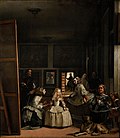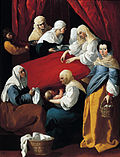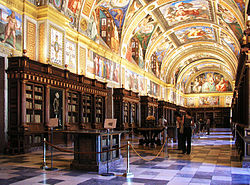Spanish Golden Age
"El Siglo de Oro," literally "the century of gold," was the Golden Age of Spain. It was a period of flowering in Spanish art and literature. It happened at about the same time that the Spanish Habsburg dynasty ruled the country. El Siglo de Oro does not have precise dates and is generally considered to have lasted more than a century. It began no earlier than 1492, with the end of Reconquista (Reconquest), Christopher Columbus's first sea voyage to the New World, and the publication of Gramática de la lengua castellana by Antonio de Navarre. Politically, it ended no later than 1659, with the Treaty of the Pyrenees which was ratified between France and Hapsburg Spain. The last great writer of the period, Pedro Calderón de la Barca, died in 1681, and his death is generally considered the end of El Siglo de Oro in art and literature.[1]
Spanish Golden Age Media
The realms of Philip II of Spain
The Defence of Cádiz Against the English oil on canvas by Francisco de Zurbarán
Las Meninas (1656, English: The Maids of Honour) by Diego Velázquez
The Birth of the Virgin by Francisco de Zurbarán
The Virgin of the Rosary (1675–80) by Bartolomé Esteban Murillo
Main altarpiece of the Toledo Cathedral by Felipe Bigarny
References
- ↑ "Siglo de Oro - A Brief Historical Background". National Park Service (United States). Retrieved January 10, 2020.









